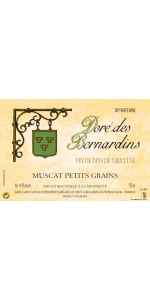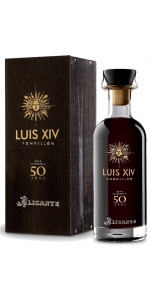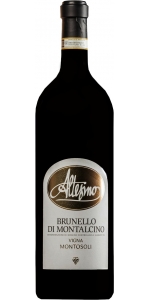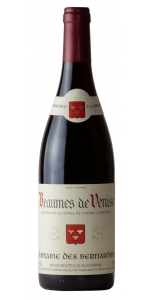Toso Vermouth di Torino Extra Dry (litre)
The Toso Estate
This one century old winery is now one of the most modern facilities in Italy, combining tradition with modern vinification techniques. The property measures 38, 000 square meters, of which 10,500 are dedicated to the vinification, the bottling and storing areas.
An early picking insures a higher acidity and a more floral bouquet. The grapes are crushed immediately to avoid any oxidation which might detract from the wine's aromas. The grapes are gently crushed and the juice is settled, centrifuged and filtered. The purified musts are placed in stainless steel tanks and held at near freezing temperatures which blocks completely any fermentation. This enables the producers to draw batches of fresh must whenever they decide to bottle. The batch of must is then inoculated with special yeast and fermented in an autoclave to retain the naturally produced carbon dioxide. The fermentation is stopped by a rapid chilling when the wine reaches the desired ratio of alcohol (standardly 7%) to residual sugar ( 3-5% ). The wine is then filtered, bottled and immediately shipped to ensure the freshest product possible.
Bernardins Dry Muscat Dore des Bernardins is made from 100% white Muscat petit grains.
Doré des Bernardins is a dry white wine that is only produced in years when the Muscat à petit grains crop is large enough. Grapes are picked at the same ripeness level as for the Vin Doux Naturel. In contrast to Muscat de Beaumes de Venise, the fermentation isn’t stopped, giving a fruity dry wine with intense Muscat aromas.
Dry Muscat with a fruity, nice perfume, honeysuckle and melon aromas, lively rounded mouth-feel. Elegant, fresh and medium-bodied.
Situation
Spreads out over the south-east side of the Dentelles de Montmirail hills, in Beaumes de Venise in the southern part of the Rhone valley.
Terroir
On a poor sandy, hungry and arid soil consisting of tender limestone and gritty zones of sandy mollasse.
In the vineyard
The vineyards and their terroir are the essence of our wines. This is where everything starts and where we focus our efforts throughout the year. You can’t make great wine without great grapes.
The viticulture is essentially done by hand. Five people work full-time in the vineyards. They are supplemented by seasonal employees who work during bunch thinning and the harvest in order to bring out the very best in our vines. Working by hand and the attention each vine gets are fundamental. Pruning, de-budding, trellising, leaf removal and picking are thus carried out by hand with the utmost care.
We prepare the soil by using good old-fashioned ploughing. Organic compost is made from grape marc (the discarded stalks and skins).
As a way of protecting the plants, we only use phytosanitary products when necessary and within strict guidelines by staggering the treatments appropriately, to minimise the amount of chemicals used. We prefer to use as much as possible manual and organic techniques. Leaving natural grass cover, removing buds and leaves from the vines, preserving biodiversity around the vineyard: olive, almond and cypress trees, wild rosemary and capers.
Winemaking
Our Doré des Bernardins is a dry white wine that we only produce in years when the Muscat à petits grains crop is large enough. We pick the grapes at the same ripeness level as for the Vin Doux Naturel. In contrast to Muscat de Beaumes, the fermentation isn’t stopped, giving a fruity dry wine with intense Muscat aromas.
Nicely chilled, this dry white wine is great as an aperitif or with asparagus, seafood, king prawns, fish.
Luis XIV Fondillon Oro 50 years NV is made from 100 percent 100% Monastrell (Mourvedre). Only 24 9 liter cases produced.
The wine is produced in the village of Cañada, in the subarea of Alto Vinalopó in the province of Alicante. Made from 100% Monastrell planted on traditional dry land as bush vines, at 550-580 meters above sea leval and enjoying a Mediterranean climate with great marine influence due to the easterly winds.
Fondillon 50 years is mahogany in color with orange tile rim, medium layer and great density. On the nose, it has a very deep aroma of old wood, black tea and carob. In the mouth, it has a sweet entry balanced by a rich high acidity. Its aromas are long, almost eternal and very intense. It tastes like old mahogany, a very old barrel and bygone times.
Bottled in December 2019.
AGEING:
CASK NAME: Saboners.
AGEING: Aged more than 50 years (single barrel).
TYPE OF WOOD: 19th-century American oak barrels
CASK SIZE: 70 “cántaros valencianos” (805 litros).
ANALYSIS:
GLUCOSE AND FRUCTOSE: 34 gr/litre.
VOLATILE ACIDITY: 1.35 gr/l.
ALCOHOL: 16.2º (NO ADDED ALCOHOL).
FREE SULFITES: less than 10 mg/litre.
TOTAL SULFITES: 76 mg/litre.
Review:
Dark mahogany color, candied fruit aromas, fruit liqueur notes, spicy, varnish, acetaldehyde, bakery, complex. Fine solera notes, bitter flavors."
- Penin 2022, 99 pts
"The NV Fondillón Luis XIV has the subtitle Edad Superior a 50 años (over 50 years old), and it's a dark mahogany, bottled from a single barrel that has the specific profile of a very old wine greatly concentrated by age, which tends to make it similar to other very old and concentrated wines, be it a Mediterranean rancio or a very old Moscatel. It has notes of bitter chocolate, coconut and iodine, carob beans (algarroba) and some bittersweet sensations. It's dense and concentrated, and the palate is pungent, with very intense flavors and a bitter twist in the finish. This has 16.3% alcohol, 6.45 grams of acidity and 34 grams of sugar, but it comes through as very dry. The wine is long and extraordinary, but it just doesn't have any Fondillón character after decades of concentration by evaporation. The price is ludicrous. Only 435 half-liter bottles were filled in December 2019. - Luis GUTIERREZ
- Wine Advocate (September 2020), 95 pts
"Fondillón is an extraordinary treasure of Alicante, a rare product, made from late harvest, non-botrytised grapes, unfortified, but with a final alcohol of no less than 16%. Intense, aged, but not sweet (deliciously not more than 45g/l). Fab with cheese or dark chocolate. The wines have to be a minimum of 10 years; this release is more than 25 years. The project is a revival by David Carbonell of Vins del Comtat and two local families. Very limited quantities. - Sarah Jane Evans MW"
- Decanter (December 2021, My top 10 Spanish fine wines of 2021), 95 pts
Altesino Brunello di Montalcino Montosoli is made from 100 percent Sangiovese.
One of the most sought after wines from Montalcino, Montosoli is consistently a blockbuster red. Its intense ruby red color tends towards elegant garnet with age. On the nose, it shows a complex personality with a delicious blend of black cherry, raspberry, violet, licorice, vanilla and black pepper. Extremely enticing, opulent and elegant on the palate, with a warm, long-lasting finish, Montosoli is a wine for special occasions.
Pair this wine with beef bourguignon and stroganoff, lamb shank, and roasted rabbit.
Review:
A juicy and lightly austere young red with blackberry, cherry and bark character on both the nose and palate. It’s medium- to full-bodied with chewy tannins that soften at the end, but still make your mouth pucker. Give this two or three years to soften. Best after 2027.
-James Suckling 97 Points
Bernardins Beaumes de Venise Rouge Cru Cotes du Rhone is made from 65% Grenache, 25% Syrah, 5% Mourvedre and 5% Grenache Blanc.
Bright ruby color with cherry tinges. Complex black fruit aromas on the nose enhanced by spicy notes. Rounded palate with good length.
The wine is drinking well right now and can be kept for another 10 years.
Situation
Spreads out over the south-east side of the Dentelles de Montmirail hills, in Beaumes de Venise in the southern part of the Rhone valley.
Terroir
On a poor sandy, hungry and arid soil consisting of tender limestone and gritty zones of sandy mollasse.
In the vineyard
The vineyards and their terroir are the essence of our wines. This is where everything starts and where we focus our efforts throughout the year. You can’t make great wine without great grapes.
The viticulture is essentially done by hand. Five people work full-time in the vineyards. They are supplemented by seasonal employees who work during bunch thinning and the harvest in order to bring out the very best in our vines. Working by hand and the attention each vine gets are fundamental. Pruning, de-budding, trellising, leaf removal and picking are thus carried out by hand with the utmost care.
We prepare the soil by using good old-fashioned ploughing. Organic compost is made from grape marc (the discarded stalks and skins).
As a way of protecting the plants, we only use phytosanitary products when necessary and within strict guidelines by staggering the treatments appropriately, to minimise the amount of chemicals used. We prefer to use as much as possible manual and organic techniques . Leaving natural grass cover, removing buds and leaves from the vines, preserving biodiversity around the vineyard: olive, almond and cypress trees, wild rosemary and capers.
Winemaking
We make two red wines at the estate. Terroir wines shaped by the two classic Côtes du Rhône varieties: Grenache and Syrah. We don’t follow any winemaking recipe but are constantly searching for the perfect expression of terroir and each vintage’s particular characteristics. We don’t go for overripe grapes and over-extraction, as we think the wine has to stay refreshing and balanced.
Leaving the wine for 15 days in concrete vats, we try to gently extract the tannins and anthocyanins essential for the wine’s structure and colour. The wine doesn’t come into any contact with wood during ageing. This way the characteristics of our terroir can fully express
Serve with a meal especially red meat, game and cheese.
Review:
"Smoky bacon, bay leaf and olive brine. This is very fine for a whole-bunch style, with lovely tannic finesse and texture. Powerful, tannic and cleansing, yet compact, with driving acidity, a dry, savoury finish and perfect balance. A good vintage, for what is a reliably good-value southern Rhône pick. Vineyards in conversion to organic; fruit is whole-bunch fermented.- Matt WALLS"
- Decanter (October 1st 2024), 94 pts
Wachau Riesling is dry and often defined by high levels of dry extract (due to a lengthy ripening period) and a pleasing freshness (due to dramatic temperature swings between day and night). Sedimentary soils of sand and stone give Kirchweg Riesling a dense mineral texture and fine fruity flavors.
Review:
I love the deep and delicate, peachy nose of this extremely attractive Wachau dry riesling. Wonderful fresh fruit with a touch of mint and lemon balm on the ripe but rather sleek and very precise palate. The power and concentration show themselves first at the stunningly long and pristine finish.
-James Suckling 96 Points
Toso Asti Spumante is made with 100 percent Moscato d' Asti
Sweet, aromatic, fruity and floral sparkling wine, moderate in alcohol, with fine sparkle and long lasting perlage. Of yellow straw color, it is a fine and elegant wine, ideal to celebrate every joyful event.
Toso Asti Spumante is made from Moscato grapes grown on hills in the South of Piedmont An early picking insures a higher acidity and a more floral bouquet. The grapes are crushed immediately to avoid any oxidation which might detract from the wine's aromas. The grapes are gently crushed and the juice is settled, centrifuged and filtered. The purified musts are placed in stainless steel tanks and held at near freezing temperatures which blocks completely any fermentation. This enables the producers to draw batches of fresh must whenever they decide to bottle. The batch of must is then inoculated with special yeast and fermented in an autoclave to retain the naturally produced carbon dioxide. The fermentation is stopped by a rapid chilling when the wine reaches the desired ratio of alcohol (standardly 7%) to residual sugar ( 3-5% ). The wine is then filtered, bottled and, at Toso, immediately shipped to ensure the freshest product possible.
Fresh, a floral bouquet, a sweet, fruity taste, Excellent as aperitif, best enjoyed with fruit, dried pastries and desserts in general.
- back
Caymus has a signature style that is dark in color, with rich fruit and ripe, velvety tannins – as approachable in youth as in maturity. We farm Cabernet grapes in eight of Napa’s 16 sub-appellations, with diversification enabling us to make the best possible wine in a given year. This Cabernet offers layered, lush aromas and flavors, including cocoa, cassis and ripe dark berries.
Holocene The Black Square Cabernet Sauvignon is made from 100 percent Cabernet Sauvignon.
There is something ethereal about Cabernet Sauvignon grown in the cobblestone soils of the Walla Walla Valley. This region offers aromatic exuberance, elegance, finesse, a polished texture, layered complexity, and remarkable length. It is a place where one can craft a singular, stand-alone example of this varietal—unique not only in the United States but worldwide—while still echoing some of our favorite wines from Bordeaux.
In 2022, Winemaker Todd Alexander embarked on a new (yet familiar) journey that he had been patiently awaiting the perfect moment to explore. The Black Square is in its inaugural vintage, and this 2022 is 100% Cabernet Sauvignon grown in the Rocks District of Milton-Freewater, Oregon, which is part of the Walla Walla Valley.
The Black Square embodies elegance and grace framed by great structure, supple texture, and acidity to ensure longevity. It shows ample fruit with complex savory notes. This is not a heavy wine that is monolithic and dull—there are already plenty of those available. This wine offers a unique expression of Cabernet; it may be the most delicious wine Todd Alexander has ever crafted, venturing into new territory for Rocks District Cabernet Sauvignon.
Review:
As black as squid ink, The Black Square is balance personified. A concentrated blackberry aroma seems as dark as the wine's name, with equally dark espresso, olive and charred steak notes joining it in the abyss. A dark plum and ripe boysenberry flavor combo is accompanied by traces of salty Mission olives, wet slate and silky smooth tannins. The one bright feature illuminating the way is the wine's amped-up acidity. None so black
-Wine Enthusiast 98 Points Number 5 in the Top 100











